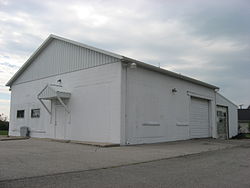베타 무스카에
Beta Muscae| 관찰 데이터 Epoch J2000.0EquinoxJ2000.0(ICRS) | |
|---|---|
| 콘스텔레이션 | 무스카 |
| 적경 | 12h 46m 16.80410s[1] |
| 적위 | - 68° 06° 29.2164°[1] |
| 겉보기 등급(V) | 3.05 (3.51 + 4.01)[2] |
| 특성. | |
| 스펙트럼형 | B2 V + B3 V[2] |
| U-B 색지수 | – 0.766[3] |
| B-V 색지수 | –0.1991[3] |
| 아스트로메트리 | |
| 반지름 속도(Rv) | +42[4] km/s |
| 고유운동(μ) | RA: – 41.97[1] mas/년 Dec.: – 8.89[1] mas/년 |
| 시차()) | 9.55 ± 0.41 mas[1] |
| 거리 | 340 ± 10 ly (105 ± 4 pc) |
| 절대 등급(MV) | - 2.06[5] |
| 궤도[6] | |
| 기간(P) | 194.28년 |
| 반장축(a) | 0.969″ |
| 편심(e) | 0.598 |
| 기울기(i) | 37.1° |
| 노드의 경도(δ) | 349.4° |
| 근일점 에폭(T) | 1857.50 |
| 근일점 인수()) (세컨더리) | 209.0° |
| 세부 사항 | |
| β 뮤스 A | |
| 덩어리 | 7.35[7] M☉ |
| 광도 | 1,892[5] L☉ |
| 나이 | 15.1 ± 1.2[8] 미르 |
| β 뮤스 B | |
| 덩어리 | 6.40[7] M☉ |
| 기타 명칭 | |
| 데이터베이스 참조 | |
| 심바디 | 데이터. |
쥐자리 베타(β Muscae)는 남반구 쥐자리에 있는 쌍성이다.겉보기 등급은 모두 3.07로 [2]별자리에서 두 번째로 밝은 별(또는 항성계)이다.시차 결과로 판단하면,[1] 이 행성은 지구로부터 약 340 ± 13광년(105 ± 4파섹) 거리에 있다.
이것은 공전 이심률 0.[6]6으로 약 194년의 주기를 가진 쌍성계입니다.2007년 현재 두 별은 35°[7]의 위치각에서 1.206초각의 각도로 떨어져 있다.성분은 크기와 모양이 비슷한 주계열성입니다.주성분인 β Muscae A의 겉보기 등급은 3.51, B2 [2]V이며 [7]질량은 태양의 약 7.35배이다.두 번째 성분인 β Muscae B의 겉보기 등급은 4.01로 B3 [2]V이며 질량은 태양의 [7]약 6.40배이다.
이것은 전갈자리-센타우루스 [2][7]성협의 확인된 멤버로, 이것은 우주를 통해 비슷한 나이, 위치, 궤적을 가진 별들로, 그들이 같은 분자 구름에서 함께 형성되었음을 암시합니다.용골자리 베타(Beta Muscae)는 정상 은하 자전에 비해 43.9kms의−1 높은 고유 속도를 가지고 있기 때문에 도주성계로 여겨진다.도망성은 다른 쌍성계와의 조우 등 여러 가지 방법을 통해 생성될 수 있습니다.쌍성계는 도망가는 [10]별의 전체 인구 중 상대적으로 작은 부분을 형성합니다.
레퍼런스
- ^ a b c d e f van Leeuwen, F. (November 2007), "Validation of the new Hipparcos reduction", Astronomy and Astrophysics, 474 (2): 653–664, arXiv:0708.1752, Bibcode:2007A&A...474..653V, doi:10.1051/0004-6361:20078357, S2CID 18759600
- ^ a b c d e f Eggleton, P. P.; Tokovinin, A. A. (September 2008), "A catalogue of multiplicity among bright stellar systems", Monthly Notices of the Royal Astronomical Society, 389 (2): 869–879, arXiv:0806.2878, Bibcode:2008MNRAS.389..869E, doi:10.1111/j.1365-2966.2008.13596.x, S2CID 14878976
- ^ a b Gutierrez-Moreno, Adelina; Moreno, Hugo (June 1968), "A Photometric Investigation of the Scorpio-Centaurus Association", Astrophysical Journal Supplement, 15: 459, Bibcode:1968ApJS...15..459G, doi:10.1086/190168
- ^ Wilson, Ralph Elmer (1953). "General Catalogue of Stellar Radial Velocities". Carnegie Institute Washington D.C. Publication. Washington: Carnegie Institution of Washington. Bibcode:1953GCRV..C......0W.
- ^ a b Anderson, E.; Francis, Ch. (2012), "XHIP: An extended hipparcos compilation", Astronomy Letters, 38 (5): 331, arXiv:1108.4971, Bibcode:2012AstL...38..331A, doi:10.1134/S1063773712050015, S2CID 119257644.
- ^ a b "Sixth Catalog of Orbits of Visual Binary Stars", U.S. Naval Observatory, archived from the original on 2009-04-12, retrieved 2008-06-22
- ^ a b c d e f Kouwenhoven, M. B. N.; Brown, A. G. A.; Portegies Zwart, S. F.; Kaper, L. (October 2007), "The primordial binary population. II. Recovering the binary population for intermediate mass stars in Scorpius OB2", Astronomy and Astrophysics, 474 (1): 77–104, arXiv:0707.2746, Bibcode:2007A&A...474...77K, doi:10.1051/0004-6361:20077719, S2CID 15750945
- ^ Tetzlaff, N.; Neuhäuser, R.; Hohle, M. M. (January 2011), "A catalogue of young runaway Hipparcos stars within 3 kpc from the Sun", Monthly Notices of the Royal Astronomical Society, 410 (1): 190–200, arXiv:1007.4883, Bibcode:2011MNRAS.410..190T, doi:10.1111/j.1365-2966.2010.17434.x, S2CID 118629873
- ^ "CCDM J12463-6806AB -- Double or multiple star", SIMBAD, Centre de Données astronomiques de Strasbourg, retrieved 2012-01-20
- ^ Hoogerwerf, R.; de Bruijne, J. H. J.; de Zeeuw, P. T. (January 2001), "On the origin of the O and B-type stars with high velocities. II. Runaway stars and pulsars ejected from the nearby young stellar groups", Astronomy and Astrophysics, 365 (2): 49–77, arXiv:astro-ph/0010057, Bibcode:2001A&A...365...49H, doi:10.1051/0004-6361:20000014, S2CID 18970167
외부 링크
- Kaler, James B., "Beta Muscae", Stars, University of Illinois, retrieved 2012-01-20



